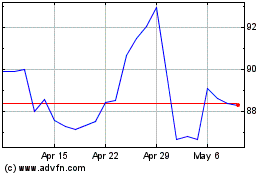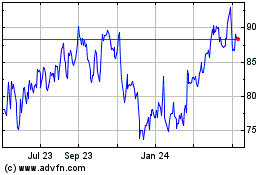Natural Gas Futures Fall Below $2/MMBtu To New 10-Year Low
April 11 2012 - 2:21PM
Dow Jones News
Natural gas futures fell below $2 a million British Thermal
Units in intraday trading Wednesday for the first time since
January 2002. The milestone was passed as weak demand and robust
production have driven prices down 55% over the last 52 weeks.
Futures were down 1.6% to $1.999/MMBtu in midday trading for the
May contract on the New York Mercantile Exchange. Prices pierced
the threshold after hovering just above it for hours.
"There's nothing that's out there right now that can push this
higher," said Scott Gettleman, an independent gas trader at the
Nymex.
Futures have been in steady decline for months now, plumbing
10-year lows on an almost weekly basis. They have tumbled below the
$2 threshold due to a host of supply and demand difficulties--few
of which show any sign of easing in the near future.
About half of all U.S. homes are heated using natural gas, and
prices typically rise in the winter. But this winter was one of the
mildest on record, squelching demand for the fuel.
At the same time, producers have shown little willingness to
reduce their record output. The decline in prices hasn't been met
with significant cuts to production. In January, Chesapeake Energy
Corp. (CHK) and ConocoPhillips (COP) both announced output
curtailments in response to falling prices, but the cuts
represented only a fraction of their production and few other
natural-gas producers followed suit.
The combination of reduced demand and abundant production has
sent prices sliding sharply. Natural gas futures are down 33% so
far this year.
Many producers, however, have shifted their drilling efforts to
focus on fields containing more profitable crude oil and natural
gas liquids. The liquids, which include ethane, propane and butane,
are crucial in the production of plastics and other products.
The number of working gas rigs in the U.S. has fallen 27% over
the last year to 647, according to oil-field services provider
Baker Hughes Inc. (BHI). At the same time, the number of oil rigs
has risen 50% to 1,329.
Still, these moves have had little impact. Gas output has
remained high because most wells produce a mix of oil and gas--no
matter whether they are classified as a natural gas well or an oil
well. High oil prices effectively are subsidizing the cost of
continued gas production in many cases. At the same time, many
producers have locked in higher gas prices on the futures market.
Others are obligated by the terms of leases on land to continue
producing gas. Such deals were struck when gas prices were much
higher.
The U.S. Energy Information Administration continues to report
record U.S. natural-gas production. Last month, the agency said
output in the lower 48 states rose to a record high of 72.85
billion cubic feet a day in January, the most recent date for which
figures are available.
The rising output is raising fears that the market could run out
of space to store gas later this year, as early as October.
Inventories now stand at 2.479 trillion cubic feet, their highest
level ever for this time of year and 60.5% above where they
typically stand at this time.
That leaves perilously little space for the typical increase in
stockpiles that takes place during the spring and summer months.
The EIA said Tuesday it expects inventories to rise to 3.923
trillion cubic feet. The agency estimates that about 4.1 trillion
cubic feet of working capacity exists across the U.S.
Additional gas demand from power generators could stall the
decline, analysts said. Barclays said power generators have been
gradually switching off coal plants and turning on gas plants,
which are growing cheaper to run. But many utilities have large
inventories of coal or long-term contracts that prevent widespread
switching.
"The power system is not prepared to respond that quickly to
this much of a drop in gas prices," said Mike Zenker, natural gas
analyst at Barclays.
However in recent weeks, speculators have been paring their bets
on lower gas prices, a sign that some of the most aggressive
selling may be over. The Commodity Futures Trading Commission
reported Friday that speculators reduced their so-called net short
position 16.6% in the most recent week.
-By Dan Strumpf, Dow Jones Newswires; 212-416-2818;
dan.strumpf@dowjones.com
Chesapeake Energy (NASDAQ:CHK)
Historical Stock Chart
From Mar 2024 to Apr 2024

Chesapeake Energy (NASDAQ:CHK)
Historical Stock Chart
From Apr 2023 to Apr 2024
